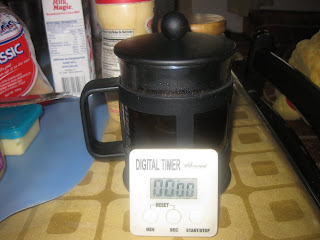Brewing a perfect cup of coffee might seemed to be a daunting task for many people; leading them to rely on the instant coffee/3in1 sachets and/or on the nearby cafes. For me, I find most of the instant coffees to be too thin on my palate. It's light body and tastes just like water only with dark color and sugar. Getting my cup of joe from a nearby cafe is delightful, but certainly expensive if done on a regular basis, like everyday.
So, I'd like to share to you how to brew the perfect cup of coffee right at your home, which I learned from the different coffee/barista courses I took and from the book "An Introduction to Coffee" by Pacita U. Juan and Ma. Regina S. Francisca.
Preparing a freshly brewed cup of coffee has 4 fundamentals:
- Freshness - To make good coffee, it is simply logical that you use good quality coffee beans. It should be always freshly roasted. It loses its flavor once it gets old. You have to consume a freshly bought pack of coffee beans within a week or two; or better keep it in batches in the freezer and thaw only what you intend to use. Grind coffee beans only what you will use right away. When you grind coffee, it also begins to lose flavor as it comes in contact with the atmosphere. Always store the coffee beans in airtight container in a cool and dry place.
- Grind - Always use the correct grind for your chosen coffeemaker. 'The longer contact time of the coffee beans with water, the coarser the grind' is what you must always remember in grinding and brewing coffee. Also, DON'T REUSE GROUNDS. Over-extracted coffee becomes bitter. Since Burr Grinder, Institutional Bean Grinder and Espresso Grinder or Doser have calibrated grind settings, here is a quick guide to grind, when using the Blade Grinder (most common kind of home coffee grinder) or the manual coffee mill or hand mill: 7-10 seconds - coarse grind (good for French Press/coffee press and Percolator);15 seconds - medium grind; 20 seconds - fine grind (good for Auto Drip Coffeemaker); 25 seconds - extra fine (good for Turkish Ibrik; and 30 seconds - for espresso.
- Proportion - For a full-bodied and flavorful cup of coffee, use 2 tablespoons per 6-ounce cup or 180 ml. You will end up with thin bitter coffee when you try to scrimp on the quantity of the coffee.
- Water - Always use filtered tap water from a good source, purified water or mineral water, but never use distilled water, since this will give you a flat-tasting brew. Also, use water of room temperature to ensure consistency in the brewing time.
Choosing your coffee beans
There are four kinds of coffee beans to choose from:
- Arabica is the most popular variety and the most expensive and sensitive bean. It grows on higher elevations, thus the flavor is more refined. This is my favorite.
- Robusta is the harsher flavor profile. It has twice as much as the caffeine of Arabica. It thrives on lower lands.
- Excelsa is commonly mistaken as Kapeng Barako, but it has a distinct jackfruit taste and grows in lower elevations.
- Liberica is the Kapeng Barako. It has the biggest trunk, leaf size, beans and cherries among the varieties.
Also, you may combine the different kinds of beans in brewing the perfect cup of coffee to reach your desired taste, like mixing arabica & robusta beans.
For me, I like to get my fresh cup of coffee by using my French Press or Coffee Press instead of the Auto Drip Coffeemaker. It is always aromatic, thick on my palate, full-bodied and flavorful. First, I measured 6 tablespoons of coffee beans and grind it (coarse grind). Next, put the coffee grounds in the French Press and pour the 540 ml water off the boil and allow it to steep. After four minutes, push down the plunger to separate the grounds from the brew. A freshly-brewed coffee is waiting for me. I like mine with creamer and muscovado sugar. How do you like your coffee?






